Organisational Leadership: Challenges and Theories in Tesco Report
VerifiedAdded on 2023/06/10
|13
|4290
|465
Report
AI Summary
This report examines organisational leadership with a focus on Tesco, a UK-based retail organisation. It delves into the nature of leadership, differentiating it from management and discussing the influence of power, politics, and conflicts. A key challenge identified is the impact of global business, exploring both its benefits (access to new cultures, increased competition) and challenges (collaboration, international recruitment). The report then analyses transformational leadership theory as a potential approach to address these challenges, emphasizing inspirational motivation, intellectual stimulation, individualised consideration, and idealised influence. The report concludes by highlighting the importance of adapting leadership styles to navigate global complexities and foster a positive and productive work environment within Tesco.
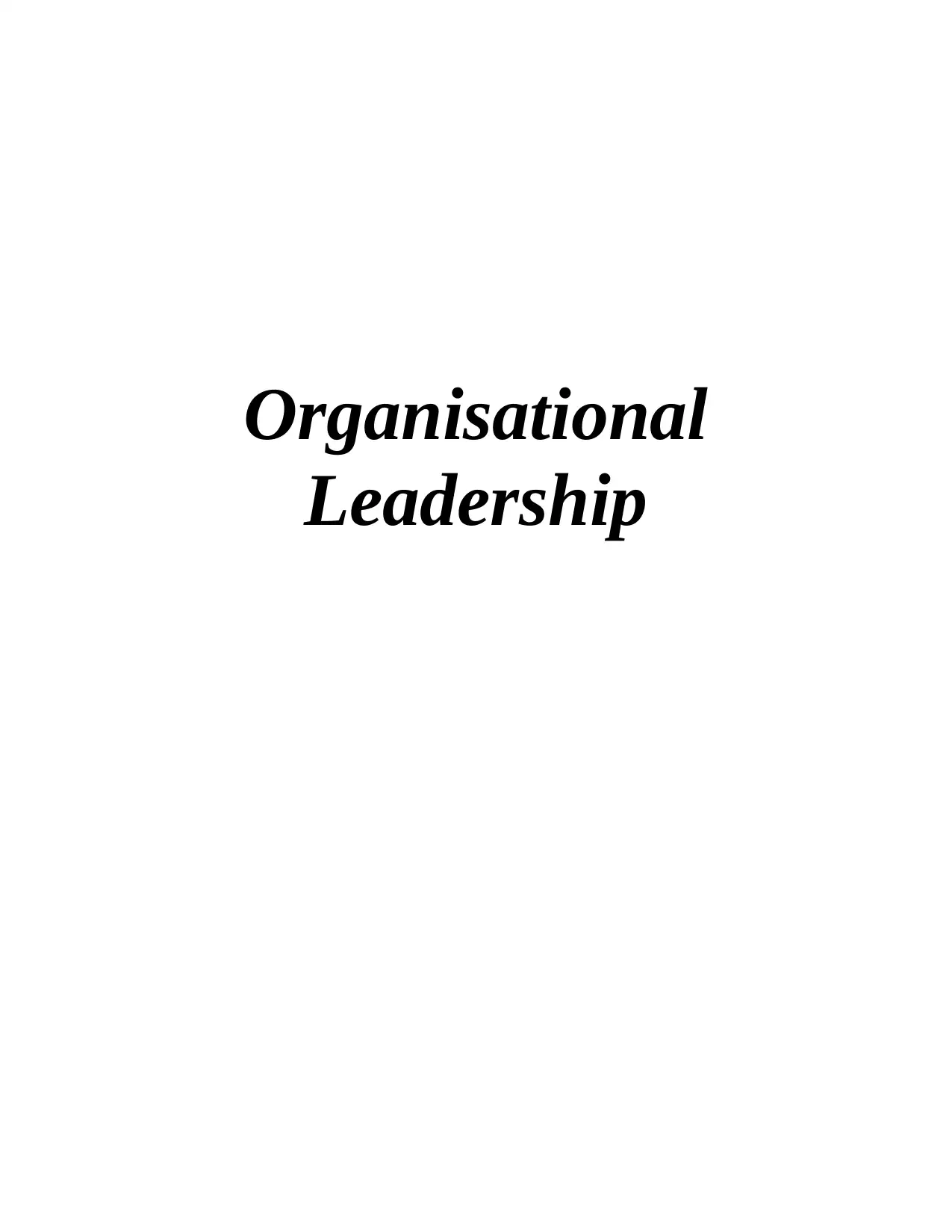
Organisational
Leadership
Leadership
Paraphrase This Document
Need a fresh take? Get an instant paraphrase of this document with our AI Paraphraser
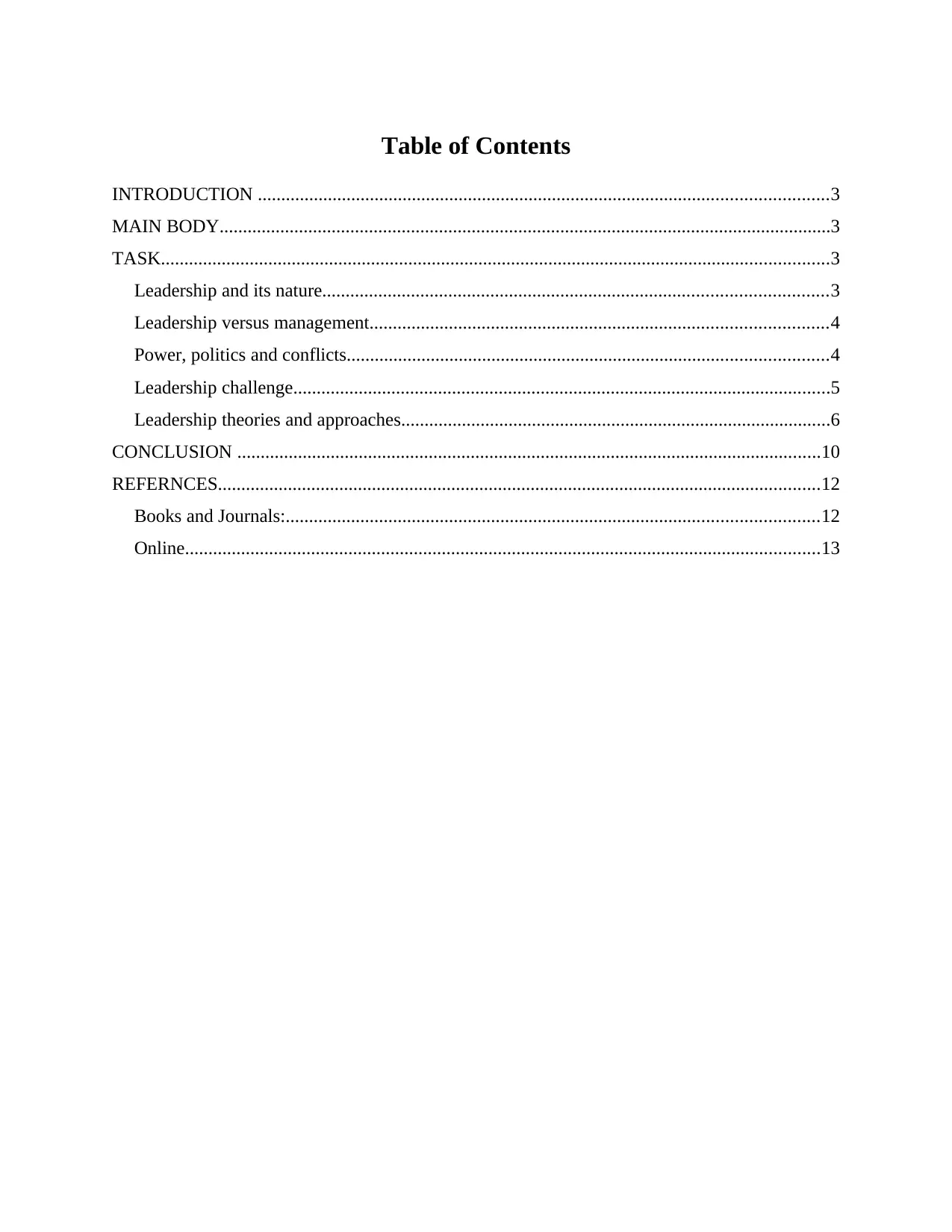
Table of Contents
INTRODUCTION ..........................................................................................................................3
MAIN BODY...................................................................................................................................3
TASK...............................................................................................................................................3
Leadership and its nature............................................................................................................3
Leadership versus management..................................................................................................4
Power, politics and conflicts.......................................................................................................4
Leadership challenge...................................................................................................................5
Leadership theories and approaches............................................................................................6
CONCLUSION .............................................................................................................................10
REFERNCES.................................................................................................................................12
Books and Journals:..................................................................................................................12
Online........................................................................................................................................13
INTRODUCTION ..........................................................................................................................3
MAIN BODY...................................................................................................................................3
TASK...............................................................................................................................................3
Leadership and its nature............................................................................................................3
Leadership versus management..................................................................................................4
Power, politics and conflicts.......................................................................................................4
Leadership challenge...................................................................................................................5
Leadership theories and approaches............................................................................................6
CONCLUSION .............................................................................................................................10
REFERNCES.................................................................................................................................12
Books and Journals:..................................................................................................................12
Online........................................................................................................................................13
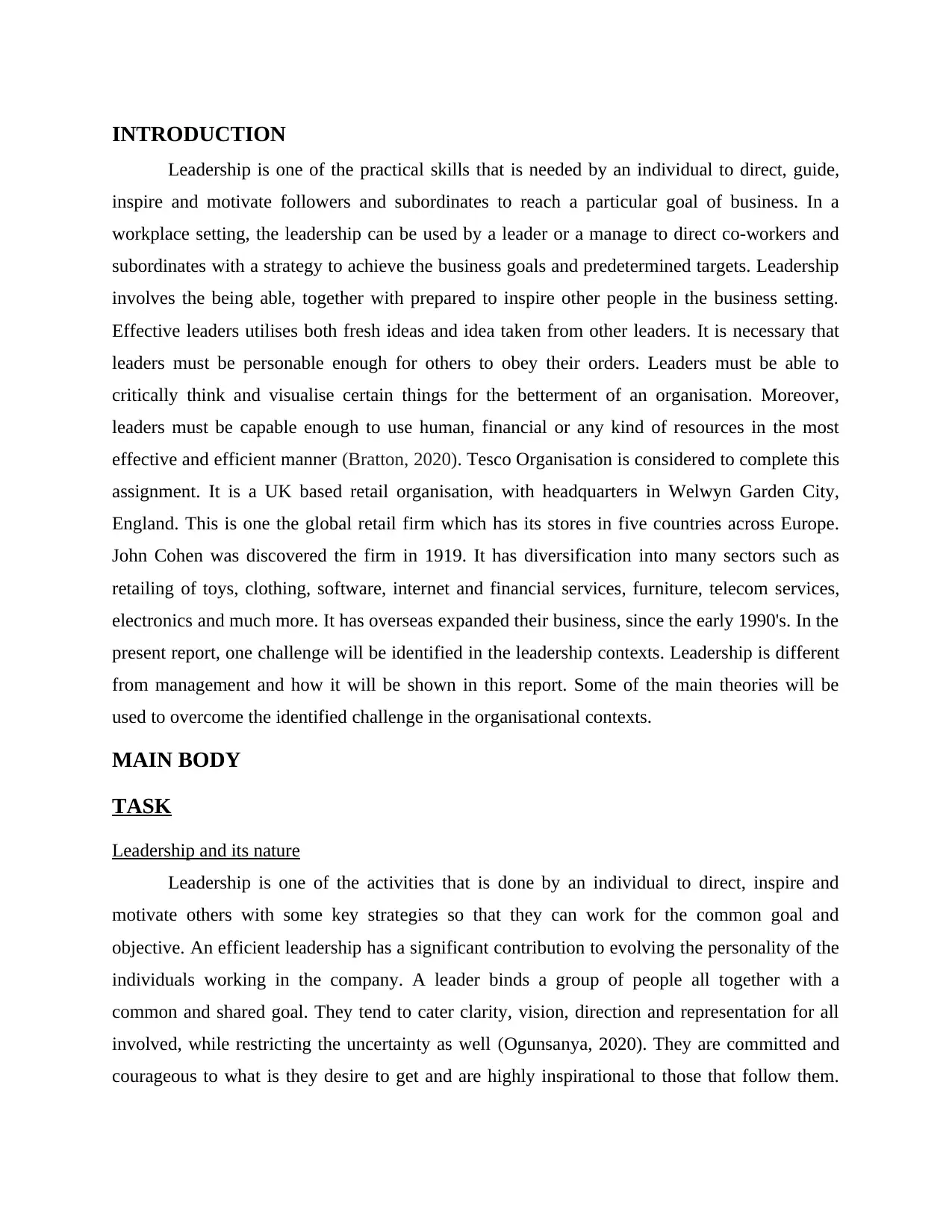
INTRODUCTION
Leadership is one of the practical skills that is needed by an individual to direct, guide,
inspire and motivate followers and subordinates to reach a particular goal of business. In a
workplace setting, the leadership can be used by a leader or a manage to direct co-workers and
subordinates with a strategy to achieve the business goals and predetermined targets. Leadership
involves the being able, together with prepared to inspire other people in the business setting.
Effective leaders utilises both fresh ideas and idea taken from other leaders. It is necessary that
leaders must be personable enough for others to obey their orders. Leaders must be able to
critically think and visualise certain things for the betterment of an organisation. Moreover,
leaders must be capable enough to use human, financial or any kind of resources in the most
effective and efficient manner (Bratton, 2020). Tesco Organisation is considered to complete this
assignment. It is a UK based retail organisation, with headquarters in Welwyn Garden City,
England. This is one the global retail firm which has its stores in five countries across Europe.
John Cohen was discovered the firm in 1919. It has diversification into many sectors such as
retailing of toys, clothing, software, internet and financial services, furniture, telecom services,
electronics and much more. It has overseas expanded their business, since the early 1990's. In the
present report, one challenge will be identified in the leadership contexts. Leadership is different
from management and how it will be shown in this report. Some of the main theories will be
used to overcome the identified challenge in the organisational contexts.
MAIN BODY
TASK
Leadership and its nature
Leadership is one of the activities that is done by an individual to direct, inspire and
motivate others with some key strategies so that they can work for the common goal and
objective. An efficient leadership has a significant contribution to evolving the personality of the
individuals working in the company. A leader binds a group of people all together with a
common and shared goal. They tend to cater clarity, vision, direction and representation for all
involved, while restricting the uncertainty as well (Ogunsanya, 2020). They are committed and
courageous to what is they desire to get and are highly inspirational to those that follow them.
Leadership is one of the practical skills that is needed by an individual to direct, guide,
inspire and motivate followers and subordinates to reach a particular goal of business. In a
workplace setting, the leadership can be used by a leader or a manage to direct co-workers and
subordinates with a strategy to achieve the business goals and predetermined targets. Leadership
involves the being able, together with prepared to inspire other people in the business setting.
Effective leaders utilises both fresh ideas and idea taken from other leaders. It is necessary that
leaders must be personable enough for others to obey their orders. Leaders must be able to
critically think and visualise certain things for the betterment of an organisation. Moreover,
leaders must be capable enough to use human, financial or any kind of resources in the most
effective and efficient manner (Bratton, 2020). Tesco Organisation is considered to complete this
assignment. It is a UK based retail organisation, with headquarters in Welwyn Garden City,
England. This is one the global retail firm which has its stores in five countries across Europe.
John Cohen was discovered the firm in 1919. It has diversification into many sectors such as
retailing of toys, clothing, software, internet and financial services, furniture, telecom services,
electronics and much more. It has overseas expanded their business, since the early 1990's. In the
present report, one challenge will be identified in the leadership contexts. Leadership is different
from management and how it will be shown in this report. Some of the main theories will be
used to overcome the identified challenge in the organisational contexts.
MAIN BODY
TASK
Leadership and its nature
Leadership is one of the activities that is done by an individual to direct, inspire and
motivate others with some key strategies so that they can work for the common goal and
objective. An efficient leadership has a significant contribution to evolving the personality of the
individuals working in the company. A leader binds a group of people all together with a
common and shared goal. They tend to cater clarity, vision, direction and representation for all
involved, while restricting the uncertainty as well (Ogunsanya, 2020). They are committed and
courageous to what is they desire to get and are highly inspirational to those that follow them.
⊘ This is a preview!⊘
Do you want full access?
Subscribe today to unlock all pages.

Trusted by 1+ million students worldwide
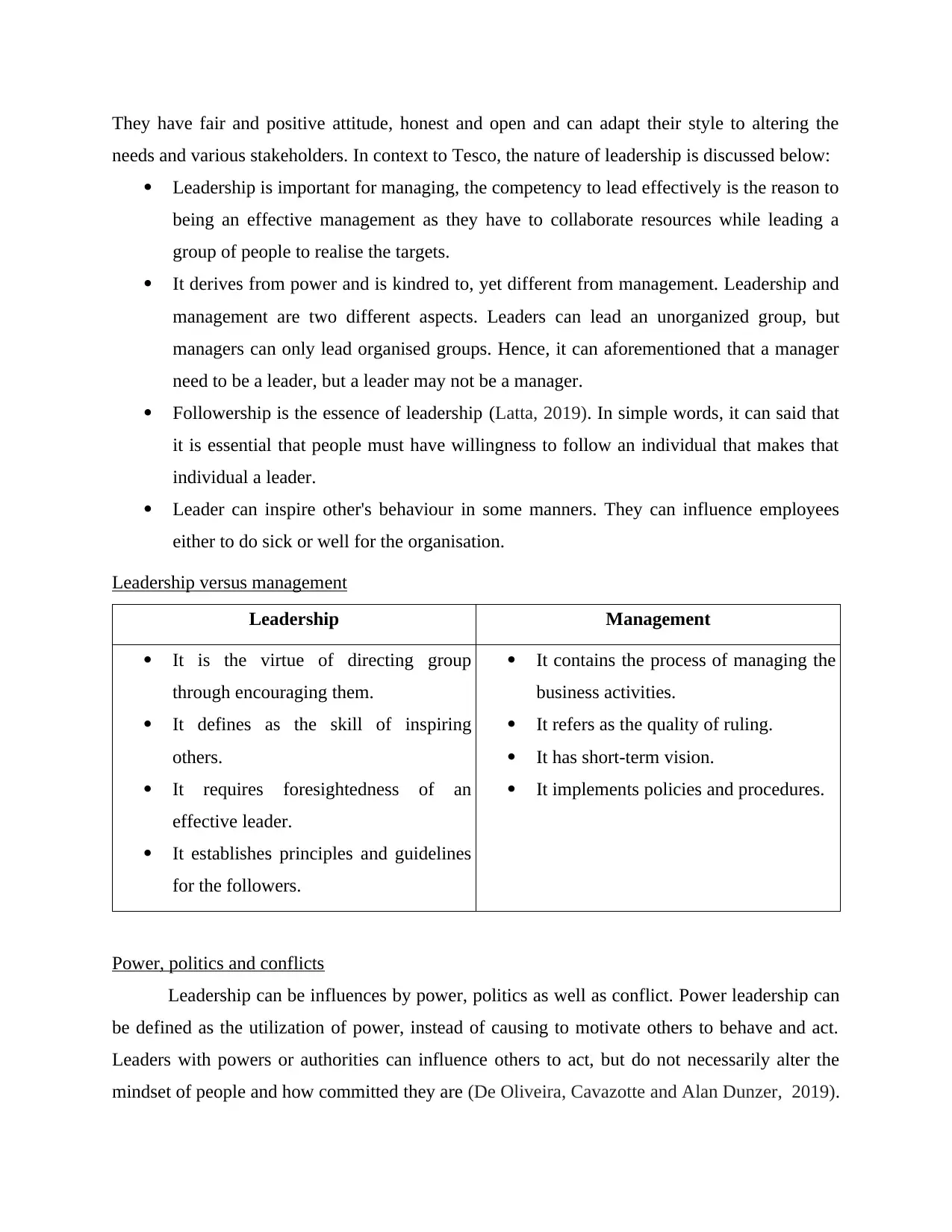
They have fair and positive attitude, honest and open and can adapt their style to altering the
needs and various stakeholders. In context to Tesco, the nature of leadership is discussed below:
Leadership is important for managing, the competency to lead effectively is the reason to
being an effective management as they have to collaborate resources while leading a
group of people to realise the targets.
It derives from power and is kindred to, yet different from management. Leadership and
management are two different aspects. Leaders can lead an unorganized group, but
managers can only lead organised groups. Hence, it can aforementioned that a manager
need to be a leader, but a leader may not be a manager.
Followership is the essence of leadership (Latta, 2019). In simple words, it can said that
it is essential that people must have willingness to follow an individual that makes that
individual a leader.
Leader can inspire other's behaviour in some manners. They can influence employees
either to do sick or well for the organisation.
Leadership versus management
Leadership Management
It is the virtue of directing group
through encouraging them.
It defines as the skill of inspiring
others.
It requires foresightedness of an
effective leader.
It establishes principles and guidelines
for the followers.
It contains the process of managing the
business activities.
It refers as the quality of ruling.
It has short-term vision.
It implements policies and procedures.
Power, politics and conflicts
Leadership can be influences by power, politics as well as conflict. Power leadership can
be defined as the utilization of power, instead of causing to motivate others to behave and act.
Leaders with powers or authorities can influence others to act, but do not necessarily alter the
mindset of people and how committed they are (De Oliveira, Cavazotte and Alan Dunzer, 2019).
needs and various stakeholders. In context to Tesco, the nature of leadership is discussed below:
Leadership is important for managing, the competency to lead effectively is the reason to
being an effective management as they have to collaborate resources while leading a
group of people to realise the targets.
It derives from power and is kindred to, yet different from management. Leadership and
management are two different aspects. Leaders can lead an unorganized group, but
managers can only lead organised groups. Hence, it can aforementioned that a manager
need to be a leader, but a leader may not be a manager.
Followership is the essence of leadership (Latta, 2019). In simple words, it can said that
it is essential that people must have willingness to follow an individual that makes that
individual a leader.
Leader can inspire other's behaviour in some manners. They can influence employees
either to do sick or well for the organisation.
Leadership versus management
Leadership Management
It is the virtue of directing group
through encouraging them.
It defines as the skill of inspiring
others.
It requires foresightedness of an
effective leader.
It establishes principles and guidelines
for the followers.
It contains the process of managing the
business activities.
It refers as the quality of ruling.
It has short-term vision.
It implements policies and procedures.
Power, politics and conflicts
Leadership can be influences by power, politics as well as conflict. Power leadership can
be defined as the utilization of power, instead of causing to motivate others to behave and act.
Leaders with powers or authorities can influence others to act, but do not necessarily alter the
mindset of people and how committed they are (De Oliveira, Cavazotte and Alan Dunzer, 2019).
Paraphrase This Document
Need a fresh take? Get an instant paraphrase of this document with our AI Paraphraser
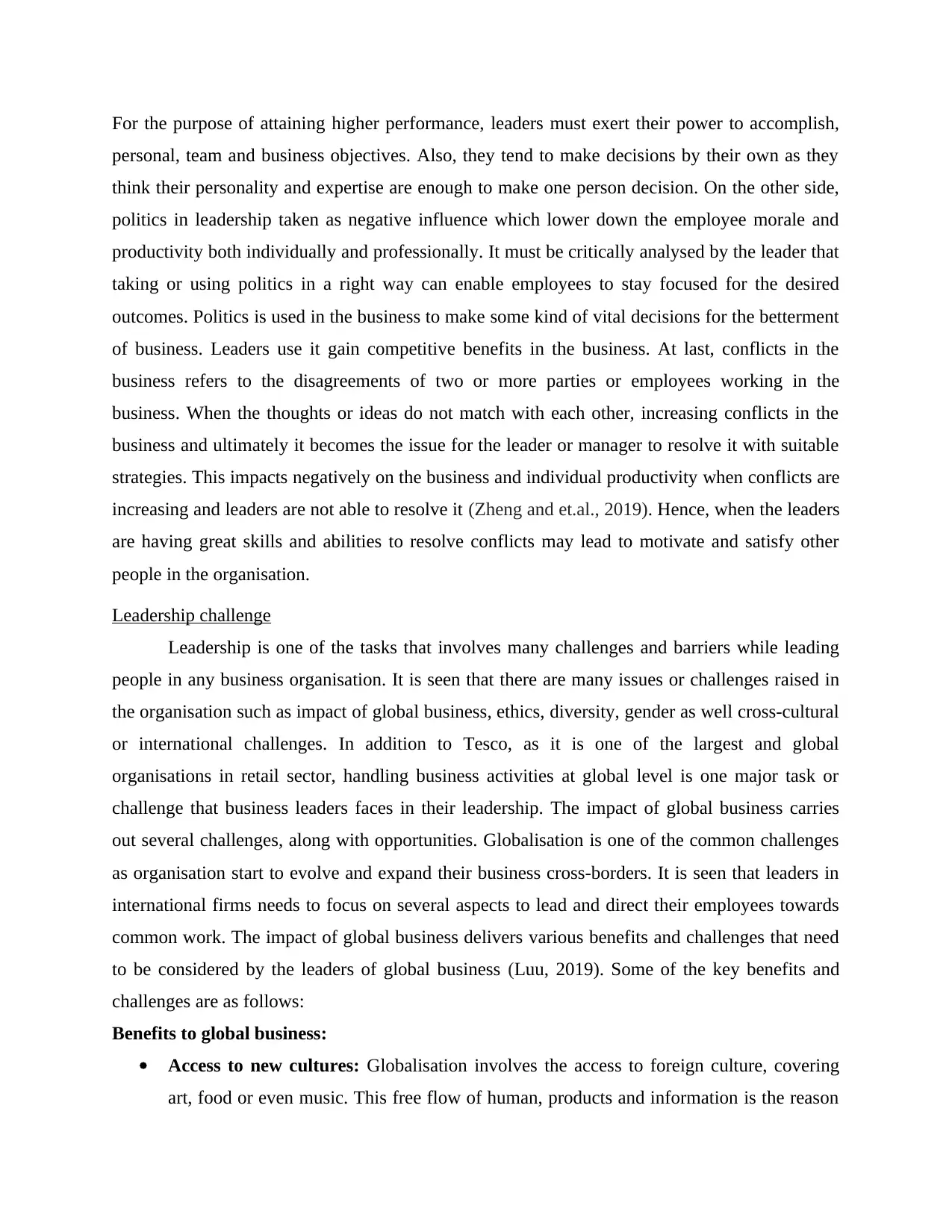
For the purpose of attaining higher performance, leaders must exert their power to accomplish,
personal, team and business objectives. Also, they tend to make decisions by their own as they
think their personality and expertise are enough to make one person decision. On the other side,
politics in leadership taken as negative influence which lower down the employee morale and
productivity both individually and professionally. It must be critically analysed by the leader that
taking or using politics in a right way can enable employees to stay focused for the desired
outcomes. Politics is used in the business to make some kind of vital decisions for the betterment
of business. Leaders use it gain competitive benefits in the business. At last, conflicts in the
business refers to the disagreements of two or more parties or employees working in the
business. When the thoughts or ideas do not match with each other, increasing conflicts in the
business and ultimately it becomes the issue for the leader or manager to resolve it with suitable
strategies. This impacts negatively on the business and individual productivity when conflicts are
increasing and leaders are not able to resolve it (Zheng and et.al., 2019). Hence, when the leaders
are having great skills and abilities to resolve conflicts may lead to motivate and satisfy other
people in the organisation.
Leadership challenge
Leadership is one of the tasks that involves many challenges and barriers while leading
people in any business organisation. It is seen that there are many issues or challenges raised in
the organisation such as impact of global business, ethics, diversity, gender as well cross-cultural
or international challenges. In addition to Tesco, as it is one of the largest and global
organisations in retail sector, handling business activities at global level is one major task or
challenge that business leaders faces in their leadership. The impact of global business carries
out several challenges, along with opportunities. Globalisation is one of the common challenges
as organisation start to evolve and expand their business cross-borders. It is seen that leaders in
international firms needs to focus on several aspects to lead and direct their employees towards
common work. The impact of global business delivers various benefits and challenges that need
to be considered by the leaders of global business (Luu, 2019). Some of the key benefits and
challenges are as follows:
Benefits to global business:
Access to new cultures: Globalisation involves the access to foreign culture, covering
art, food or even music. This free flow of human, products and information is the reason
personal, team and business objectives. Also, they tend to make decisions by their own as they
think their personality and expertise are enough to make one person decision. On the other side,
politics in leadership taken as negative influence which lower down the employee morale and
productivity both individually and professionally. It must be critically analysed by the leader that
taking or using politics in a right way can enable employees to stay focused for the desired
outcomes. Politics is used in the business to make some kind of vital decisions for the betterment
of business. Leaders use it gain competitive benefits in the business. At last, conflicts in the
business refers to the disagreements of two or more parties or employees working in the
business. When the thoughts or ideas do not match with each other, increasing conflicts in the
business and ultimately it becomes the issue for the leader or manager to resolve it with suitable
strategies. This impacts negatively on the business and individual productivity when conflicts are
increasing and leaders are not able to resolve it (Zheng and et.al., 2019). Hence, when the leaders
are having great skills and abilities to resolve conflicts may lead to motivate and satisfy other
people in the organisation.
Leadership challenge
Leadership is one of the tasks that involves many challenges and barriers while leading
people in any business organisation. It is seen that there are many issues or challenges raised in
the organisation such as impact of global business, ethics, diversity, gender as well cross-cultural
or international challenges. In addition to Tesco, as it is one of the largest and global
organisations in retail sector, handling business activities at global level is one major task or
challenge that business leaders faces in their leadership. The impact of global business carries
out several challenges, along with opportunities. Globalisation is one of the common challenges
as organisation start to evolve and expand their business cross-borders. It is seen that leaders in
international firms needs to focus on several aspects to lead and direct their employees towards
common work. The impact of global business delivers various benefits and challenges that need
to be considered by the leaders of global business (Luu, 2019). Some of the key benefits and
challenges are as follows:
Benefits to global business:
Access to new cultures: Globalisation involves the access to foreign culture, covering
art, food or even music. This free flow of human, products and information is the reason
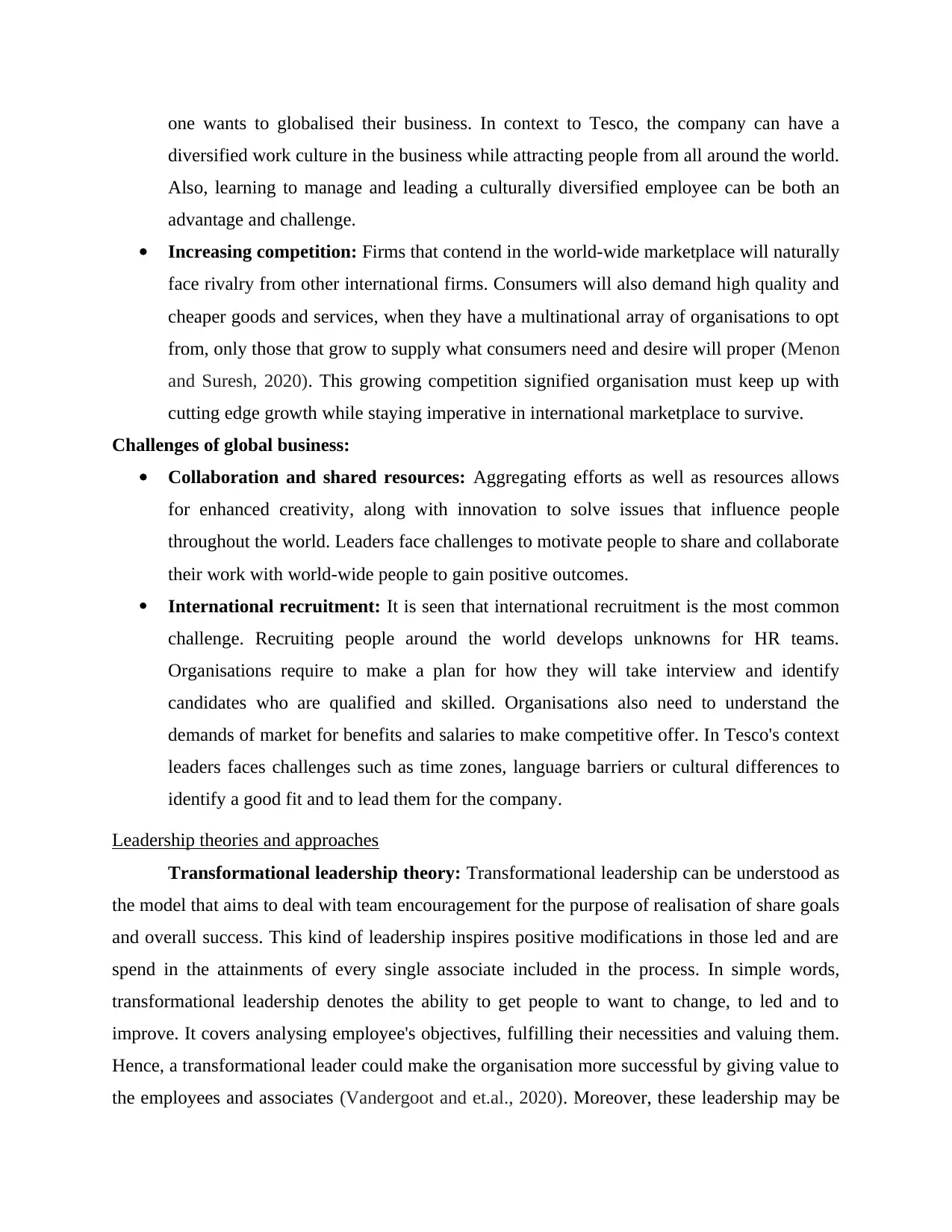
one wants to globalised their business. In context to Tesco, the company can have a
diversified work culture in the business while attracting people from all around the world.
Also, learning to manage and leading a culturally diversified employee can be both an
advantage and challenge.
Increasing competition: Firms that contend in the world-wide marketplace will naturally
face rivalry from other international firms. Consumers will also demand high quality and
cheaper goods and services, when they have a multinational array of organisations to opt
from, only those that grow to supply what consumers need and desire will proper (Menon
and Suresh, 2020). This growing competition signified organisation must keep up with
cutting edge growth while staying imperative in international marketplace to survive.
Challenges of global business:
Collaboration and shared resources: Aggregating efforts as well as resources allows
for enhanced creativity, along with innovation to solve issues that influence people
throughout the world. Leaders face challenges to motivate people to share and collaborate
their work with world-wide people to gain positive outcomes.
International recruitment: It is seen that international recruitment is the most common
challenge. Recruiting people around the world develops unknowns for HR teams.
Organisations require to make a plan for how they will take interview and identify
candidates who are qualified and skilled. Organisations also need to understand the
demands of market for benefits and salaries to make competitive offer. In Tesco's context
leaders faces challenges such as time zones, language barriers or cultural differences to
identify a good fit and to lead them for the company.
Leadership theories and approaches
Transformational leadership theory: Transformational leadership can be understood as
the model that aims to deal with team encouragement for the purpose of realisation of share goals
and overall success. This kind of leadership inspires positive modifications in those led and are
spend in the attainments of every single associate included in the process. In simple words,
transformational leadership denotes the ability to get people to want to change, to led and to
improve. It covers analysing employee's objectives, fulfilling their necessities and valuing them.
Hence, a transformational leader could make the organisation more successful by giving value to
the employees and associates (Vandergoot and et.al., 2020). Moreover, these leadership may be
diversified work culture in the business while attracting people from all around the world.
Also, learning to manage and leading a culturally diversified employee can be both an
advantage and challenge.
Increasing competition: Firms that contend in the world-wide marketplace will naturally
face rivalry from other international firms. Consumers will also demand high quality and
cheaper goods and services, when they have a multinational array of organisations to opt
from, only those that grow to supply what consumers need and desire will proper (Menon
and Suresh, 2020). This growing competition signified organisation must keep up with
cutting edge growth while staying imperative in international marketplace to survive.
Challenges of global business:
Collaboration and shared resources: Aggregating efforts as well as resources allows
for enhanced creativity, along with innovation to solve issues that influence people
throughout the world. Leaders face challenges to motivate people to share and collaborate
their work with world-wide people to gain positive outcomes.
International recruitment: It is seen that international recruitment is the most common
challenge. Recruiting people around the world develops unknowns for HR teams.
Organisations require to make a plan for how they will take interview and identify
candidates who are qualified and skilled. Organisations also need to understand the
demands of market for benefits and salaries to make competitive offer. In Tesco's context
leaders faces challenges such as time zones, language barriers or cultural differences to
identify a good fit and to lead them for the company.
Leadership theories and approaches
Transformational leadership theory: Transformational leadership can be understood as
the model that aims to deal with team encouragement for the purpose of realisation of share goals
and overall success. This kind of leadership inspires positive modifications in those led and are
spend in the attainments of every single associate included in the process. In simple words,
transformational leadership denotes the ability to get people to want to change, to led and to
improve. It covers analysing employee's objectives, fulfilling their necessities and valuing them.
Hence, a transformational leader could make the organisation more successful by giving value to
the employees and associates (Vandergoot and et.al., 2020). Moreover, these leadership may be
⊘ This is a preview!⊘
Do you want full access?
Subscribe today to unlock all pages.

Trusted by 1+ million students worldwide
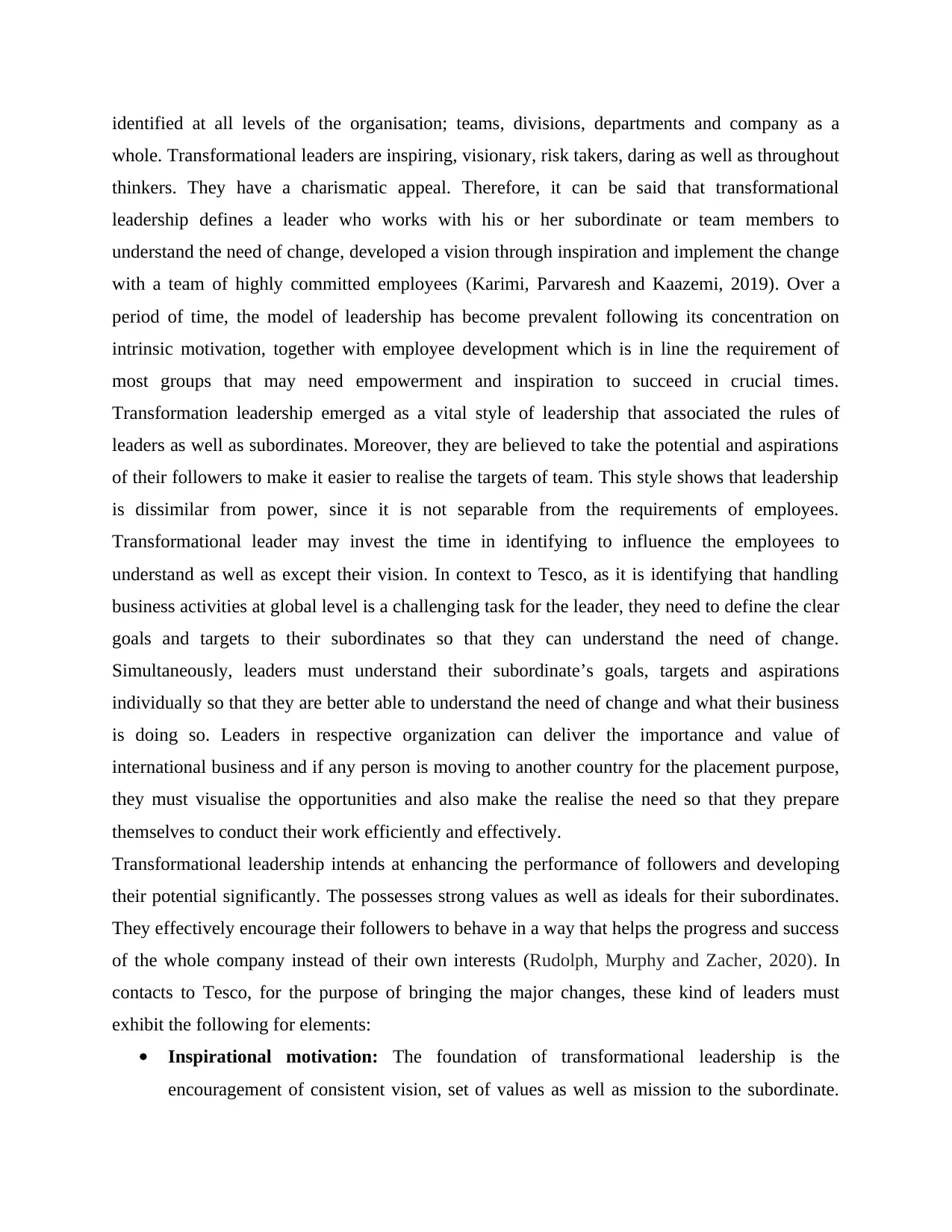
identified at all levels of the organisation; teams, divisions, departments and company as a
whole. Transformational leaders are inspiring, visionary, risk takers, daring as well as throughout
thinkers. They have a charismatic appeal. Therefore, it can be said that transformational
leadership defines a leader who works with his or her subordinate or team members to
understand the need of change, developed a vision through inspiration and implement the change
with a team of highly committed employees (Karimi, Parvaresh and Kaazemi, 2019). Over a
period of time, the model of leadership has become prevalent following its concentration on
intrinsic motivation, together with employee development which is in line the requirement of
most groups that may need empowerment and inspiration to succeed in crucial times.
Transformation leadership emerged as a vital style of leadership that associated the rules of
leaders as well as subordinates. Moreover, they are believed to take the potential and aspirations
of their followers to make it easier to realise the targets of team. This style shows that leadership
is dissimilar from power, since it is not separable from the requirements of employees.
Transformational leader may invest the time in identifying to influence the employees to
understand as well as except their vision. In context to Tesco, as it is identifying that handling
business activities at global level is a challenging task for the leader, they need to define the clear
goals and targets to their subordinates so that they can understand the need of change.
Simultaneously, leaders must understand their subordinate’s goals, targets and aspirations
individually so that they are better able to understand the need of change and what their business
is doing so. Leaders in respective organization can deliver the importance and value of
international business and if any person is moving to another country for the placement purpose,
they must visualise the opportunities and also make the realise the need so that they prepare
themselves to conduct their work efficiently and effectively.
Transformational leadership intends at enhancing the performance of followers and developing
their potential significantly. The possesses strong values as well as ideals for their subordinates.
They effectively encourage their followers to behave in a way that helps the progress and success
of the whole company instead of their own interests (Rudolph, Murphy and Zacher, 2020). In
contacts to Tesco, for the purpose of bringing the major changes, these kind of leaders must
exhibit the following for elements:
Inspirational motivation: The foundation of transformational leadership is the
encouragement of consistent vision, set of values as well as mission to the subordinate.
whole. Transformational leaders are inspiring, visionary, risk takers, daring as well as throughout
thinkers. They have a charismatic appeal. Therefore, it can be said that transformational
leadership defines a leader who works with his or her subordinate or team members to
understand the need of change, developed a vision through inspiration and implement the change
with a team of highly committed employees (Karimi, Parvaresh and Kaazemi, 2019). Over a
period of time, the model of leadership has become prevalent following its concentration on
intrinsic motivation, together with employee development which is in line the requirement of
most groups that may need empowerment and inspiration to succeed in crucial times.
Transformation leadership emerged as a vital style of leadership that associated the rules of
leaders as well as subordinates. Moreover, they are believed to take the potential and aspirations
of their followers to make it easier to realise the targets of team. This style shows that leadership
is dissimilar from power, since it is not separable from the requirements of employees.
Transformational leader may invest the time in identifying to influence the employees to
understand as well as except their vision. In context to Tesco, as it is identifying that handling
business activities at global level is a challenging task for the leader, they need to define the clear
goals and targets to their subordinates so that they can understand the need of change.
Simultaneously, leaders must understand their subordinate’s goals, targets and aspirations
individually so that they are better able to understand the need of change and what their business
is doing so. Leaders in respective organization can deliver the importance and value of
international business and if any person is moving to another country for the placement purpose,
they must visualise the opportunities and also make the realise the need so that they prepare
themselves to conduct their work efficiently and effectively.
Transformational leadership intends at enhancing the performance of followers and developing
their potential significantly. The possesses strong values as well as ideals for their subordinates.
They effectively encourage their followers to behave in a way that helps the progress and success
of the whole company instead of their own interests (Rudolph, Murphy and Zacher, 2020). In
contacts to Tesco, for the purpose of bringing the major changes, these kind of leaders must
exhibit the following for elements:
Inspirational motivation: The foundation of transformational leadership is the
encouragement of consistent vision, set of values as well as mission to the subordinate.
Paraphrase This Document
Need a fresh take? Get an instant paraphrase of this document with our AI Paraphraser
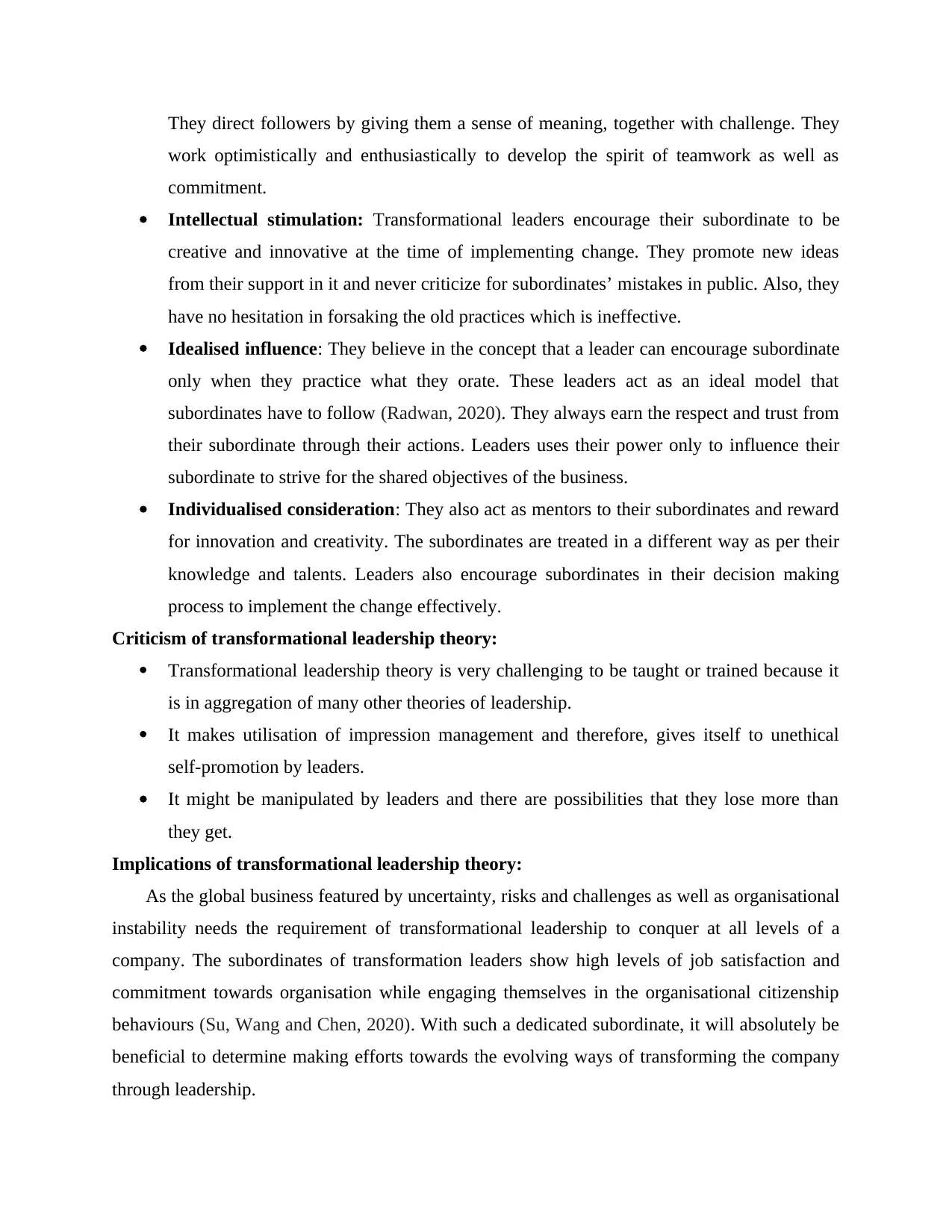
They direct followers by giving them a sense of meaning, together with challenge. They
work optimistically and enthusiastically to develop the spirit of teamwork as well as
commitment.
Intellectual stimulation: Transformational leaders encourage their subordinate to be
creative and innovative at the time of implementing change. They promote new ideas
from their support in it and never criticize for subordinates’ mistakes in public. Also, they
have no hesitation in forsaking the old practices which is ineffective.
Idealised influence: They believe in the concept that a leader can encourage subordinate
only when they practice what they orate. These leaders act as an ideal model that
subordinates have to follow (Radwan, 2020). They always earn the respect and trust from
their subordinate through their actions. Leaders uses their power only to influence their
subordinate to strive for the shared objectives of the business.
Individualised consideration: They also act as mentors to their subordinates and reward
for innovation and creativity. The subordinates are treated in a different way as per their
knowledge and talents. Leaders also encourage subordinates in their decision making
process to implement the change effectively.
Criticism of transformational leadership theory:
Transformational leadership theory is very challenging to be taught or trained because it
is in aggregation of many other theories of leadership.
It makes utilisation of impression management and therefore, gives itself to unethical
self-promotion by leaders.
It might be manipulated by leaders and there are possibilities that they lose more than
they get.
Implications of transformational leadership theory:
As the global business featured by uncertainty, risks and challenges as well as organisational
instability needs the requirement of transformational leadership to conquer at all levels of a
company. The subordinates of transformation leaders show high levels of job satisfaction and
commitment towards organisation while engaging themselves in the organisational citizenship
behaviours (Su, Wang and Chen, 2020). With such a dedicated subordinate, it will absolutely be
beneficial to determine making efforts towards the evolving ways of transforming the company
through leadership.
work optimistically and enthusiastically to develop the spirit of teamwork as well as
commitment.
Intellectual stimulation: Transformational leaders encourage their subordinate to be
creative and innovative at the time of implementing change. They promote new ideas
from their support in it and never criticize for subordinates’ mistakes in public. Also, they
have no hesitation in forsaking the old practices which is ineffective.
Idealised influence: They believe in the concept that a leader can encourage subordinate
only when they practice what they orate. These leaders act as an ideal model that
subordinates have to follow (Radwan, 2020). They always earn the respect and trust from
their subordinate through their actions. Leaders uses their power only to influence their
subordinate to strive for the shared objectives of the business.
Individualised consideration: They also act as mentors to their subordinates and reward
for innovation and creativity. The subordinates are treated in a different way as per their
knowledge and talents. Leaders also encourage subordinates in their decision making
process to implement the change effectively.
Criticism of transformational leadership theory:
Transformational leadership theory is very challenging to be taught or trained because it
is in aggregation of many other theories of leadership.
It makes utilisation of impression management and therefore, gives itself to unethical
self-promotion by leaders.
It might be manipulated by leaders and there are possibilities that they lose more than
they get.
Implications of transformational leadership theory:
As the global business featured by uncertainty, risks and challenges as well as organisational
instability needs the requirement of transformational leadership to conquer at all levels of a
company. The subordinates of transformation leaders show high levels of job satisfaction and
commitment towards organisation while engaging themselves in the organisational citizenship
behaviours (Su, Wang and Chen, 2020). With such a dedicated subordinate, it will absolutely be
beneficial to determine making efforts towards the evolving ways of transforming the company
through leadership.
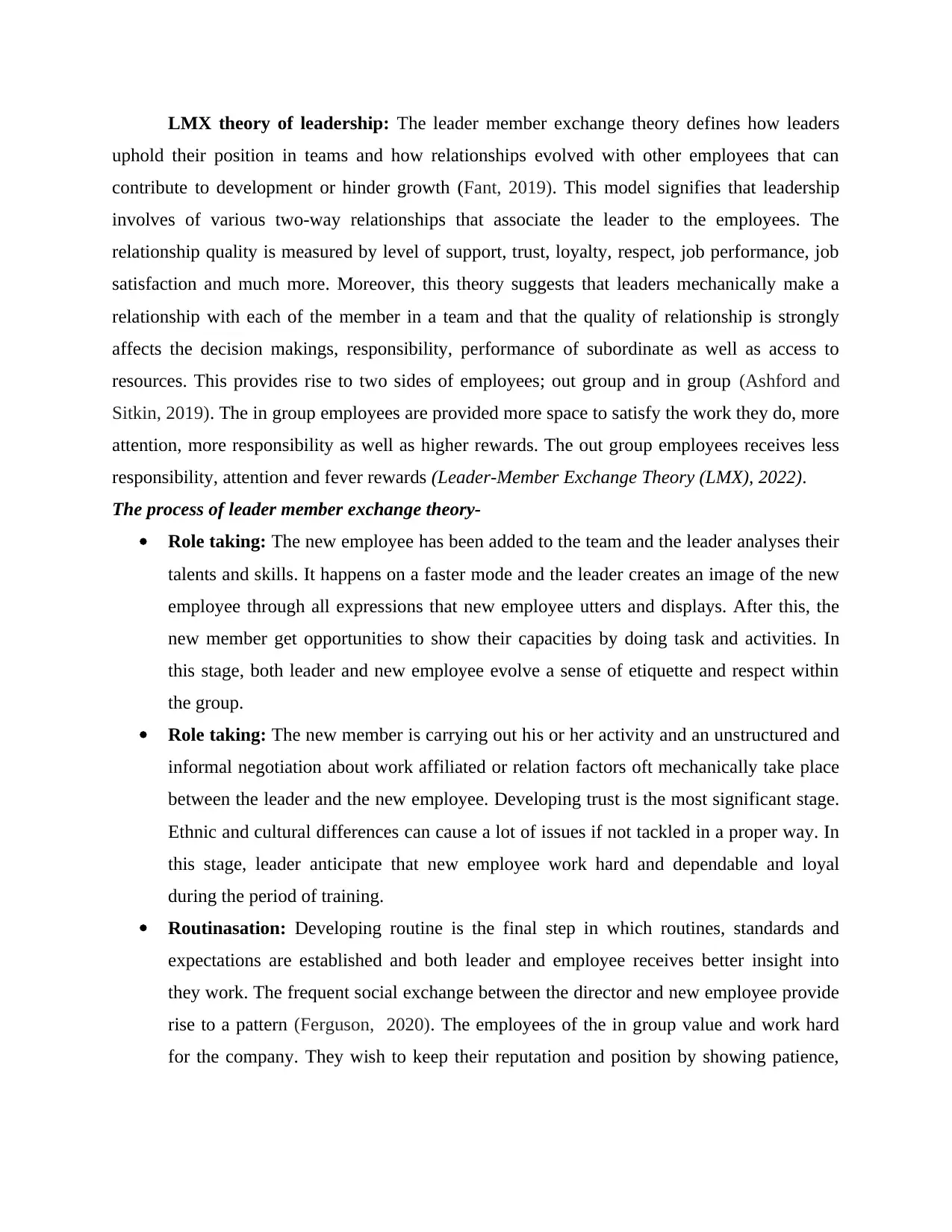
LMX theory of leadership: The leader member exchange theory defines how leaders
uphold their position in teams and how relationships evolved with other employees that can
contribute to development or hinder growth (Fant, 2019). This model signifies that leadership
involves of various two-way relationships that associate the leader to the employees. The
relationship quality is measured by level of support, trust, loyalty, respect, job performance, job
satisfaction and much more. Moreover, this theory suggests that leaders mechanically make a
relationship with each of the member in a team and that the quality of relationship is strongly
affects the decision makings, responsibility, performance of subordinate as well as access to
resources. This provides rise to two sides of employees; out group and in group (Ashford and
Sitkin, 2019). The in group employees are provided more space to satisfy the work they do, more
attention, more responsibility as well as higher rewards. The out group employees receives less
responsibility, attention and fever rewards (Leader-Member Exchange Theory (LMX), 2022).
The process of leader member exchange theory-
Role taking: The new employee has been added to the team and the leader analyses their
talents and skills. It happens on a faster mode and the leader creates an image of the new
employee through all expressions that new employee utters and displays. After this, the
new member get opportunities to show their capacities by doing task and activities. In
this stage, both leader and new employee evolve a sense of etiquette and respect within
the group.
Role taking: The new member is carrying out his or her activity and an unstructured and
informal negotiation about work affiliated or relation factors oft mechanically take place
between the leader and the new employee. Developing trust is the most significant stage.
Ethnic and cultural differences can cause a lot of issues if not tackled in a proper way. In
this stage, leader anticipate that new employee work hard and dependable and loyal
during the period of training.
Routinasation: Developing routine is the final step in which routines, standards and
expectations are established and both leader and employee receives better insight into
they work. The frequent social exchange between the director and new employee provide
rise to a pattern (Ferguson, 2020). The employees of the in group value and work hard
for the company. They wish to keep their reputation and position by showing patience,
uphold their position in teams and how relationships evolved with other employees that can
contribute to development or hinder growth (Fant, 2019). This model signifies that leadership
involves of various two-way relationships that associate the leader to the employees. The
relationship quality is measured by level of support, trust, loyalty, respect, job performance, job
satisfaction and much more. Moreover, this theory suggests that leaders mechanically make a
relationship with each of the member in a team and that the quality of relationship is strongly
affects the decision makings, responsibility, performance of subordinate as well as access to
resources. This provides rise to two sides of employees; out group and in group (Ashford and
Sitkin, 2019). The in group employees are provided more space to satisfy the work they do, more
attention, more responsibility as well as higher rewards. The out group employees receives less
responsibility, attention and fever rewards (Leader-Member Exchange Theory (LMX), 2022).
The process of leader member exchange theory-
Role taking: The new employee has been added to the team and the leader analyses their
talents and skills. It happens on a faster mode and the leader creates an image of the new
employee through all expressions that new employee utters and displays. After this, the
new member get opportunities to show their capacities by doing task and activities. In
this stage, both leader and new employee evolve a sense of etiquette and respect within
the group.
Role taking: The new member is carrying out his or her activity and an unstructured and
informal negotiation about work affiliated or relation factors oft mechanically take place
between the leader and the new employee. Developing trust is the most significant stage.
Ethnic and cultural differences can cause a lot of issues if not tackled in a proper way. In
this stage, leader anticipate that new employee work hard and dependable and loyal
during the period of training.
Routinasation: Developing routine is the final step in which routines, standards and
expectations are established and both leader and employee receives better insight into
they work. The frequent social exchange between the director and new employee provide
rise to a pattern (Ferguson, 2020). The employees of the in group value and work hard
for the company. They wish to keep their reputation and position by showing patience,
⊘ This is a preview!⊘
Do you want full access?
Subscribe today to unlock all pages.

Trusted by 1+ million students worldwide
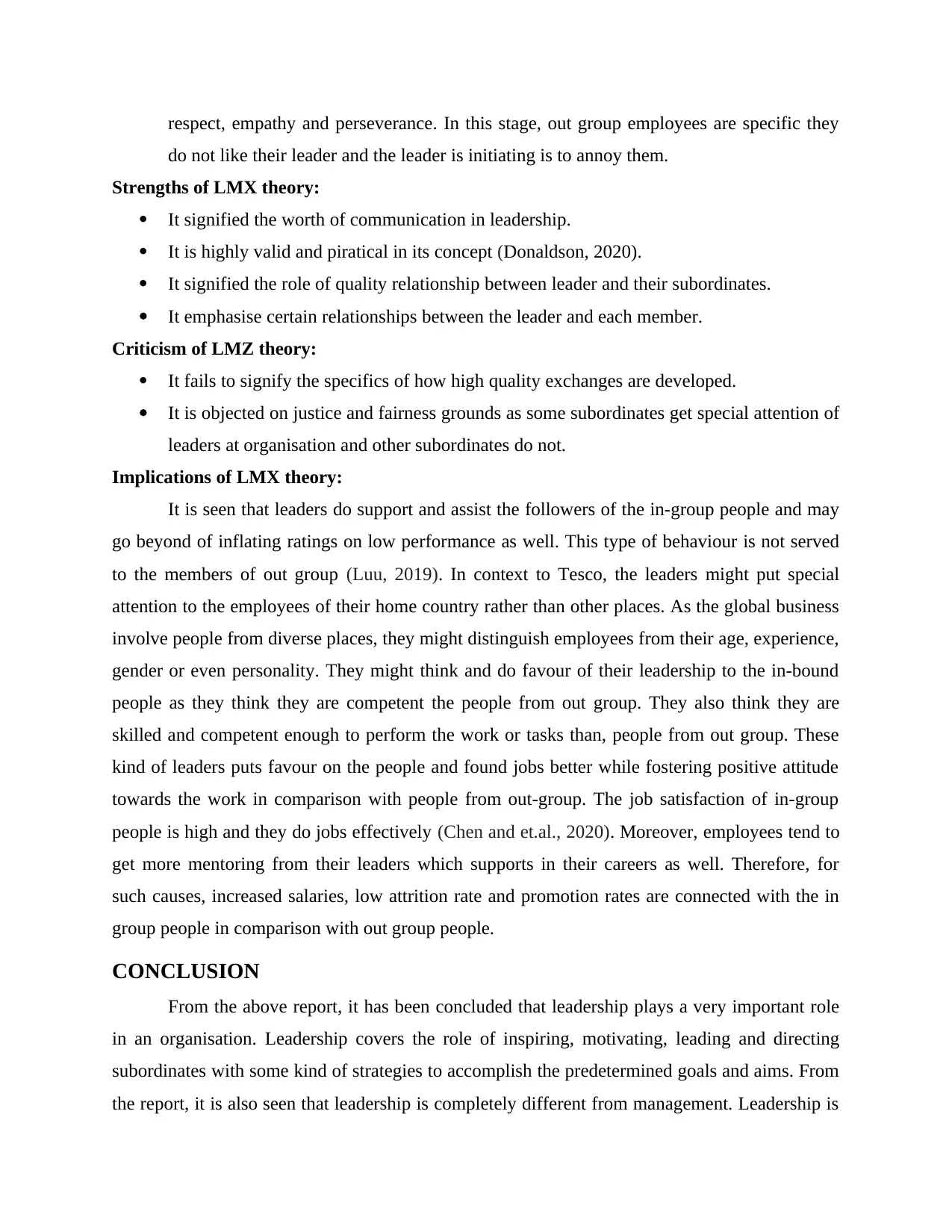
respect, empathy and perseverance. In this stage, out group employees are specific they
do not like their leader and the leader is initiating is to annoy them.
Strengths of LMX theory:
It signified the worth of communication in leadership.
It is highly valid and piratical in its concept (Donaldson, 2020).
It signified the role of quality relationship between leader and their subordinates.
It emphasise certain relationships between the leader and each member.
Criticism of LMZ theory:
It fails to signify the specifics of how high quality exchanges are developed.
It is objected on justice and fairness grounds as some subordinates get special attention of
leaders at organisation and other subordinates do not.
Implications of LMX theory:
It is seen that leaders do support and assist the followers of the in-group people and may
go beyond of inflating ratings on low performance as well. This type of behaviour is not served
to the members of out group (Luu, 2019). In context to Tesco, the leaders might put special
attention to the employees of their home country rather than other places. As the global business
involve people from diverse places, they might distinguish employees from their age, experience,
gender or even personality. They might think and do favour of their leadership to the in-bound
people as they think they are competent the people from out group. They also think they are
skilled and competent enough to perform the work or tasks than, people from out group. These
kind of leaders puts favour on the people and found jobs better while fostering positive attitude
towards the work in comparison with people from out-group. The job satisfaction of in-group
people is high and they do jobs effectively (Chen and et.al., 2020). Moreover, employees tend to
get more mentoring from their leaders which supports in their careers as well. Therefore, for
such causes, increased salaries, low attrition rate and promotion rates are connected with the in
group people in comparison with out group people.
CONCLUSION
From the above report, it has been concluded that leadership plays a very important role
in an organisation. Leadership covers the role of inspiring, motivating, leading and directing
subordinates with some kind of strategies to accomplish the predetermined goals and aims. From
the report, it is also seen that leadership is completely different from management. Leadership is
do not like their leader and the leader is initiating is to annoy them.
Strengths of LMX theory:
It signified the worth of communication in leadership.
It is highly valid and piratical in its concept (Donaldson, 2020).
It signified the role of quality relationship between leader and their subordinates.
It emphasise certain relationships between the leader and each member.
Criticism of LMZ theory:
It fails to signify the specifics of how high quality exchanges are developed.
It is objected on justice and fairness grounds as some subordinates get special attention of
leaders at organisation and other subordinates do not.
Implications of LMX theory:
It is seen that leaders do support and assist the followers of the in-group people and may
go beyond of inflating ratings on low performance as well. This type of behaviour is not served
to the members of out group (Luu, 2019). In context to Tesco, the leaders might put special
attention to the employees of their home country rather than other places. As the global business
involve people from diverse places, they might distinguish employees from their age, experience,
gender or even personality. They might think and do favour of their leadership to the in-bound
people as they think they are competent the people from out group. They also think they are
skilled and competent enough to perform the work or tasks than, people from out group. These
kind of leaders puts favour on the people and found jobs better while fostering positive attitude
towards the work in comparison with people from out-group. The job satisfaction of in-group
people is high and they do jobs effectively (Chen and et.al., 2020). Moreover, employees tend to
get more mentoring from their leaders which supports in their careers as well. Therefore, for
such causes, increased salaries, low attrition rate and promotion rates are connected with the in
group people in comparison with out group people.
CONCLUSION
From the above report, it has been concluded that leadership plays a very important role
in an organisation. Leadership covers the role of inspiring, motivating, leading and directing
subordinates with some kind of strategies to accomplish the predetermined goals and aims. From
the report, it is also seen that leadership is completely different from management. Leadership is
Paraphrase This Document
Need a fresh take? Get an instant paraphrase of this document with our AI Paraphraser
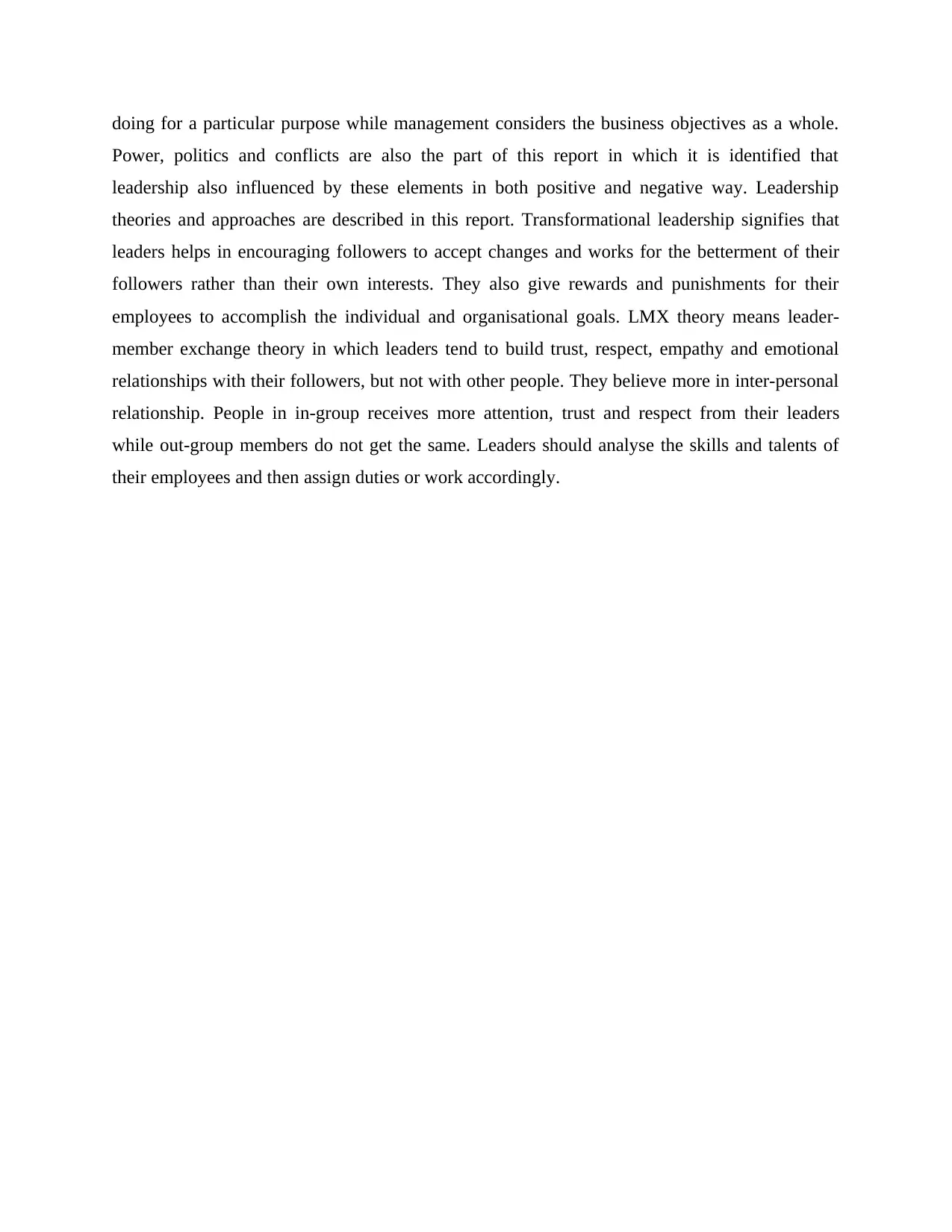
doing for a particular purpose while management considers the business objectives as a whole.
Power, politics and conflicts are also the part of this report in which it is identified that
leadership also influenced by these elements in both positive and negative way. Leadership
theories and approaches are described in this report. Transformational leadership signifies that
leaders helps in encouraging followers to accept changes and works for the betterment of their
followers rather than their own interests. They also give rewards and punishments for their
employees to accomplish the individual and organisational goals. LMX theory means leader-
member exchange theory in which leaders tend to build trust, respect, empathy and emotional
relationships with their followers, but not with other people. They believe more in inter-personal
relationship. People in in-group receives more attention, trust and respect from their leaders
while out-group members do not get the same. Leaders should analyse the skills and talents of
their employees and then assign duties or work accordingly.
Power, politics and conflicts are also the part of this report in which it is identified that
leadership also influenced by these elements in both positive and negative way. Leadership
theories and approaches are described in this report. Transformational leadership signifies that
leaders helps in encouraging followers to accept changes and works for the betterment of their
followers rather than their own interests. They also give rewards and punishments for their
employees to accomplish the individual and organisational goals. LMX theory means leader-
member exchange theory in which leaders tend to build trust, respect, empathy and emotional
relationships with their followers, but not with other people. They believe more in inter-personal
relationship. People in in-group receives more attention, trust and respect from their leaders
while out-group members do not get the same. Leaders should analyse the skills and talents of
their employees and then assign duties or work accordingly.
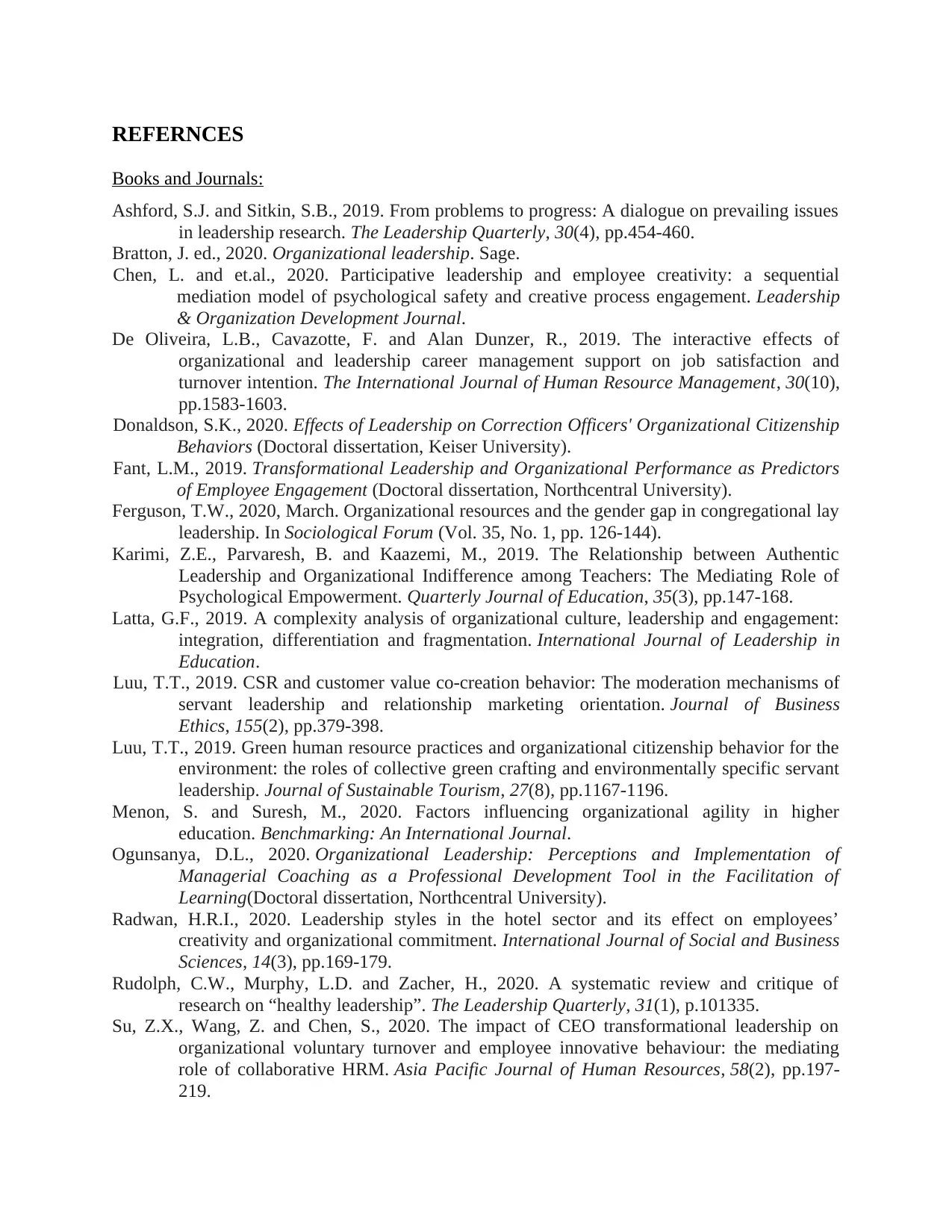
REFERNCES
Books and Journals:
Ashford, S.J. and Sitkin, S.B., 2019. From problems to progress: A dialogue on prevailing issues
in leadership research. The Leadership Quarterly, 30(4), pp.454-460.
Bratton, J. ed., 2020. Organizational leadership. Sage.
Chen, L. and et.al., 2020. Participative leadership and employee creativity: a sequential
mediation model of psychological safety and creative process engagement. Leadership
& Organization Development Journal.
De Oliveira, L.B., Cavazotte, F. and Alan Dunzer, R., 2019. The interactive effects of
organizational and leadership career management support on job satisfaction and
turnover intention. The International Journal of Human Resource Management, 30(10),
pp.1583-1603.
Donaldson, S.K., 2020. Effects of Leadership on Correction Officers' Organizational Citizenship
Behaviors (Doctoral dissertation, Keiser University).
Fant, L.M., 2019. Transformational Leadership and Organizational Performance as Predictors
of Employee Engagement (Doctoral dissertation, Northcentral University).
Ferguson, T.W., 2020, March. Organizational resources and the gender gap in congregational lay
leadership. In Sociological Forum (Vol. 35, No. 1, pp. 126-144).
Karimi, Z.E., Parvaresh, B. and Kaazemi, M., 2019. The Relationship between Authentic
Leadership and Organizational Indifference among Teachers: The Mediating Role of
Psychological Empowerment. Quarterly Journal of Education, 35(3), pp.147-168.
Latta, G.F., 2019. A complexity analysis of organizational culture, leadership and engagement:
integration, differentiation and fragmentation. International Journal of Leadership in
Education.
Luu, T.T., 2019. CSR and customer value co-creation behavior: The moderation mechanisms of
servant leadership and relationship marketing orientation. Journal of Business
Ethics, 155(2), pp.379-398.
Luu, T.T., 2019. Green human resource practices and organizational citizenship behavior for the
environment: the roles of collective green crafting and environmentally specific servant
leadership. Journal of Sustainable Tourism, 27(8), pp.1167-1196.
Menon, S. and Suresh, M., 2020. Factors influencing organizational agility in higher
education. Benchmarking: An International Journal.
Ogunsanya, D.L., 2020. Organizational Leadership: Perceptions and Implementation of
Managerial Coaching as a Professional Development Tool in the Facilitation of
Learning(Doctoral dissertation, Northcentral University).
Radwan, H.R.I., 2020. Leadership styles in the hotel sector and its effect on employees’
creativity and organizational commitment. International Journal of Social and Business
Sciences, 14(3), pp.169-179.
Rudolph, C.W., Murphy, L.D. and Zacher, H., 2020. A systematic review and critique of
research on “healthy leadership”. The Leadership Quarterly, 31(1), p.101335.
Su, Z.X., Wang, Z. and Chen, S., 2020. The impact of CEO transformational leadership on
organizational voluntary turnover and employee innovative behaviour: the mediating
role of collaborative HRM. Asia Pacific Journal of Human Resources, 58(2), pp.197-
219.
Books and Journals:
Ashford, S.J. and Sitkin, S.B., 2019. From problems to progress: A dialogue on prevailing issues
in leadership research. The Leadership Quarterly, 30(4), pp.454-460.
Bratton, J. ed., 2020. Organizational leadership. Sage.
Chen, L. and et.al., 2020. Participative leadership and employee creativity: a sequential
mediation model of psychological safety and creative process engagement. Leadership
& Organization Development Journal.
De Oliveira, L.B., Cavazotte, F. and Alan Dunzer, R., 2019. The interactive effects of
organizational and leadership career management support on job satisfaction and
turnover intention. The International Journal of Human Resource Management, 30(10),
pp.1583-1603.
Donaldson, S.K., 2020. Effects of Leadership on Correction Officers' Organizational Citizenship
Behaviors (Doctoral dissertation, Keiser University).
Fant, L.M., 2019. Transformational Leadership and Organizational Performance as Predictors
of Employee Engagement (Doctoral dissertation, Northcentral University).
Ferguson, T.W., 2020, March. Organizational resources and the gender gap in congregational lay
leadership. In Sociological Forum (Vol. 35, No. 1, pp. 126-144).
Karimi, Z.E., Parvaresh, B. and Kaazemi, M., 2019. The Relationship between Authentic
Leadership and Organizational Indifference among Teachers: The Mediating Role of
Psychological Empowerment. Quarterly Journal of Education, 35(3), pp.147-168.
Latta, G.F., 2019. A complexity analysis of organizational culture, leadership and engagement:
integration, differentiation and fragmentation. International Journal of Leadership in
Education.
Luu, T.T., 2019. CSR and customer value co-creation behavior: The moderation mechanisms of
servant leadership and relationship marketing orientation. Journal of Business
Ethics, 155(2), pp.379-398.
Luu, T.T., 2019. Green human resource practices and organizational citizenship behavior for the
environment: the roles of collective green crafting and environmentally specific servant
leadership. Journal of Sustainable Tourism, 27(8), pp.1167-1196.
Menon, S. and Suresh, M., 2020. Factors influencing organizational agility in higher
education. Benchmarking: An International Journal.
Ogunsanya, D.L., 2020. Organizational Leadership: Perceptions and Implementation of
Managerial Coaching as a Professional Development Tool in the Facilitation of
Learning(Doctoral dissertation, Northcentral University).
Radwan, H.R.I., 2020. Leadership styles in the hotel sector and its effect on employees’
creativity and organizational commitment. International Journal of Social and Business
Sciences, 14(3), pp.169-179.
Rudolph, C.W., Murphy, L.D. and Zacher, H., 2020. A systematic review and critique of
research on “healthy leadership”. The Leadership Quarterly, 31(1), p.101335.
Su, Z.X., Wang, Z. and Chen, S., 2020. The impact of CEO transformational leadership on
organizational voluntary turnover and employee innovative behaviour: the mediating
role of collaborative HRM. Asia Pacific Journal of Human Resources, 58(2), pp.197-
219.
⊘ This is a preview!⊘
Do you want full access?
Subscribe today to unlock all pages.

Trusted by 1+ million students worldwide
1 out of 13
Related Documents
Your All-in-One AI-Powered Toolkit for Academic Success.
+13062052269
info@desklib.com
Available 24*7 on WhatsApp / Email
![[object Object]](/_next/static/media/star-bottom.7253800d.svg)
Unlock your academic potential
Copyright © 2020–2025 A2Z Services. All Rights Reserved. Developed and managed by ZUCOL.




